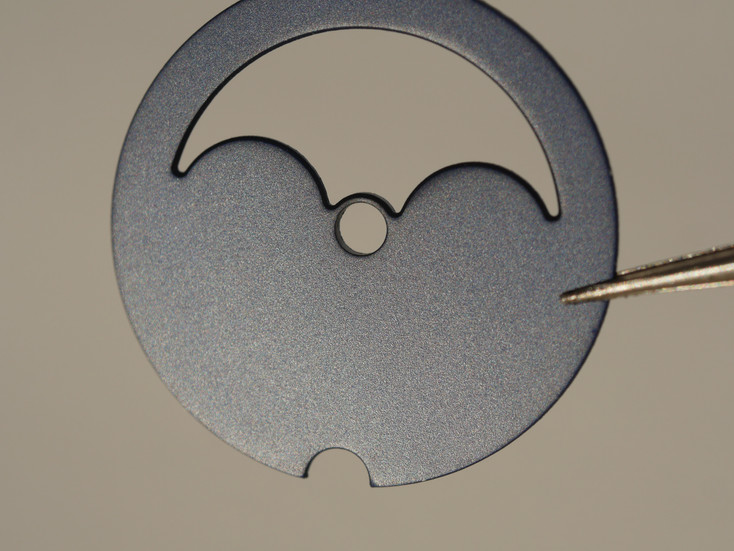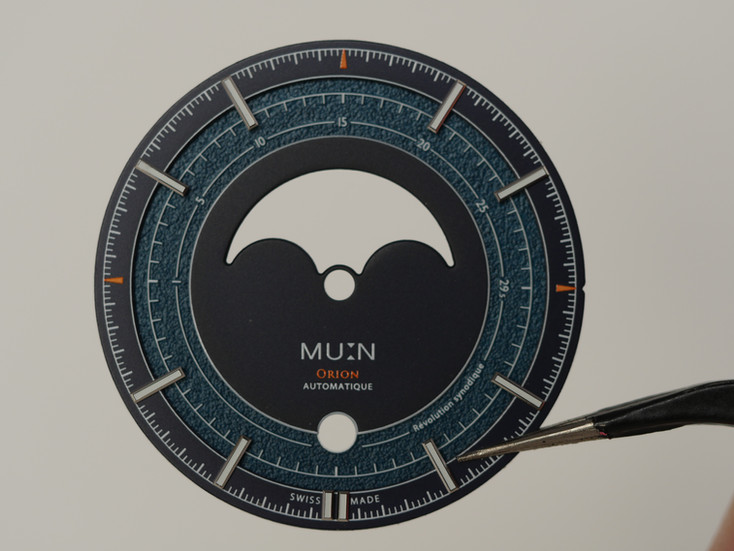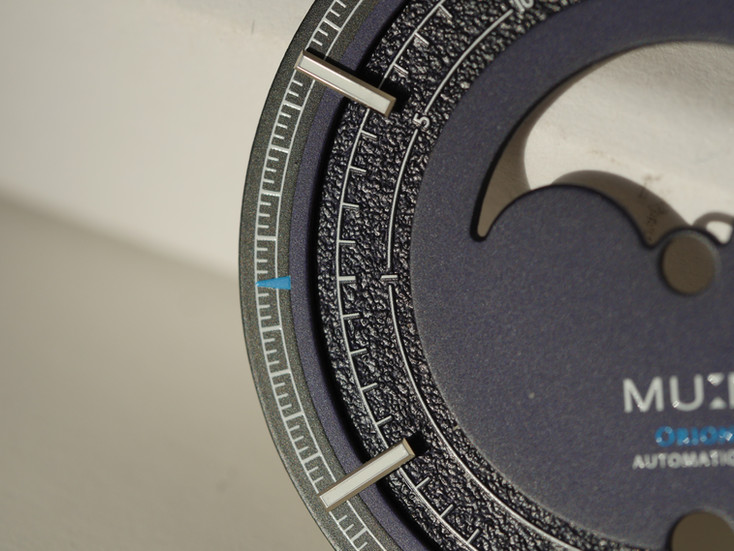FOCUS #5 - Series prototypes of the ORION dial
- Thibault
- Dec 22, 2024
- 5 min read
Updated: Jan 6
On November 14, 2024, the final prototyping of the dials was initiated . Various modifications were made to improve the finishes and the play of light on the dial. In this article, we return to the manufacturing methods used , as well as the dial chosen for series production.

This article follows Focus #3 - Construction of the dial ,
which looks at the materials used and the embossing technique.
In this last round of prototyping, our efforts focused on two aspects: (i) improving the grain texture on the lower dial , and (ii) integrate a slight sandblasted effect on the upper part . Four new methods were tested and ten new parts received during November. The final process was validated by the technical office on December 10, and series production was initiated for 1,000 parts. Delivery remains scheduled for March 2025, in accordance with the provisional schedule.
UPPER DIAL
MICROSANDBLASTED
For the upper part of the dial, we wanted to add depth and a slight relief to the material, in order to better respond to the lower grain. The goal was to keep a fine and uniform surface, but to guard against a smooth surface with a plastic effect .
To achieve this, the office worked on different degrees of micro-blasting . This treatment technique consists of projecting tiny glass beads at high pressure onto the surface of the metal. The dial is then fixed on a rotating support to ensure a regular application. This method offers a visually homogeneous, matt rendering with a sandblasted finish visible to the naked eye. The paint is then applied to the entire piece and covers the deposited micro beads.

The microblasting, close to a very light paper grain, is only noticeable under macro zoom. This additional treatment adds a deeper light capture and very subtle color variations.
LOWER DIAL
THE FOUR PROTOTYPES
- CIRCULAR BRUSHING
Process (A)
METHOD
The first test carried out deploys a very light brushing on the entire part . This particular finish is carried out using rotating abrasive brushes. This method makes it possible to create micro-scratches oriented in different concentric circles on the entire work surface. The part is then treated by spraying a thin layer of matte paint.
GOALS
The aim was to bring anisotropy to the piece - that is, variable reflections that depend on the viewer's orientation. To counterbalance the shiny effect, a matte paint was chosen.
OFFICE REPORT ❌
Despite the application of a matte paint, the brushing takes over the part. The result is a uniform, overly accentuated shimmer. The Pantone (editor's note: the color) is fully respected, regardless of the play of light. The grains have an accentuated depth, but the overall rendering remains too sparkling . This method is not retained in the series prototype.
- GLOSSY COATING
Process (B)
METHOD
The second test carried out involves a varnishing upstream of the application of the paint. The part is cleaned, and a chemical treatment is applied to optimize its adhesion. Spray nozzles (by mechanical arms) then atomize the varnish into fine droplets thanks to a combination of compressed air and liquid pressure. The matte paint is then applied by spray.
OBJECTIVES & RESULTS
The aim was to provide a uniform light reaction to the piece, by applying a single, diffuse layer. The matte paint chosen made it possible to counterbalance the shiny appearance of the piece, and to attenuate its sparkling reflections.
OFFICE REPORT ✔️
The addition of a glossy coating homogenizes the entire piece , without losing the depth of the grain. The Pantone is fully respected and the original color resists the play of light, even intense. The reaction to sharp rays of light is preserved, with a slight anisotropic effect, without unwanted flickering. This method is retained in series prototype.
- MATTE COATING
Process (C)
METHOD
The third test carried out deploys a matte coating upstream of the application of the paint. After cleaning the part and applying a chemical adhesion treatment, a matte varnish is sprayed over the entire part. A low temperature baking allows the part to dry, before applying a paint, also matte over the entire part.
OBJECTIVES & RESULTS
The choice of a matte on matte coating aims to limit the scintillation , already accentuated by the grained texture of the dial. It also allows the minute and lunar graduation not to be marked by intense light.
OFFICE REPORT ❌
While applying a matte coating adds depth of grain, the coating alters the Pantone . The color darkens across the entire piece, smoothing out the nuances. The Pantone is altered, darkening by several shades. This method is not retained in series prototypes.
- SEMI-GLOSS COATING
Process (D)
METHOD
For the third test, a mixture of varnish is made beforehand by the workshop, to create an alchemy between glossy and matte coating (40/60). The latter is applied by spraying on the part and completed, following the same process, with a matte paint.
GOALS
The objective here is to assess the influence of the varnish on the color and light reaction, particularly with regard to the grain retained. In accordance with an A/B test logic, the creation of an A+B prototype allows both to assess the nuance of the first tests, but also to work on an intermediate solution. The addition of a semi-gloss coating meets the same objectives of limiting flicker, depth of grain, and preservation of light effects.
OFFICE REPORT ❌
If the reaction of the material lived up to our expectations, with subtle reflections of light and plays of texture, the matte coating nevertheless alters the Pantone like the prototype (C). The plays of light are accentuated by the addition of a satin solution, at the cost of an appearance of purple nuances. The Pantone is not respected. This method is not retained in series prototype.
SERIAL SAMPLES
THE FOUR PROTOTYPES
The following were selected: process B with matte coating, as well as the sandblasted finish for the upper dial. These parts constitute the last regulatory inspection before approval for series production, which began in December.
Below are the pre-production samples validated by the office.
The entire team remains at your disposal, and wishes you a wonderful holiday season. You can find the latest news from the ORION series and follow the production step by step in your personal space .
See you soon for the next #FOCUS The Mu:n team










































































Great to see the update. Still hoping for the red seconds hand for the blue dial - seemed to have strong support from the Kickstarter page
Thank you for the amazing detail, the samples look fantastic. I notice the final prototypes still state “Automatique”. Assume that will be changed on the Production dials in accordance with the change in the movement?
I am impressed about your thoughtful und thoroughly r&d process and I am sure to receive a real jewel as soon as you will have started delivery.
Having said that I want to wish all the best to everyone at mu:n. Have a great 2025!
Keep on the great work and keep the updates floating, which personally I like a lot.
What about the strap selection?